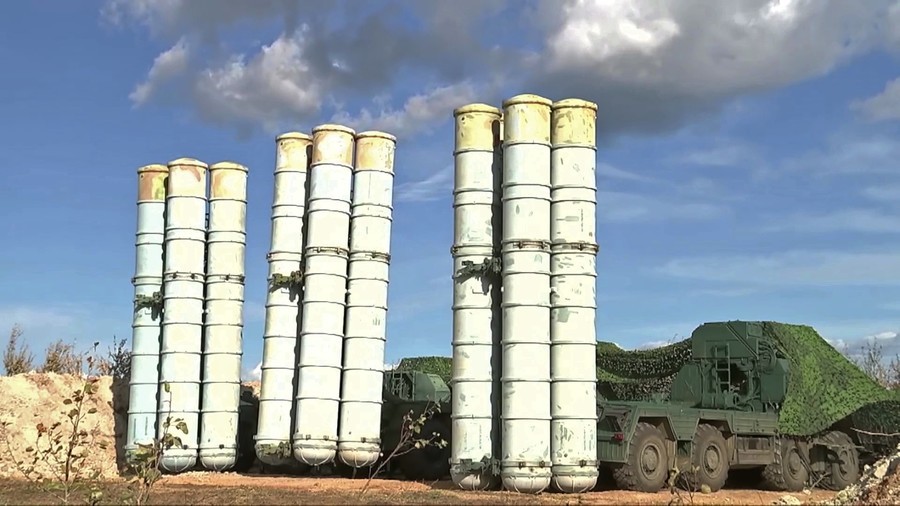
The Syrian Army has long sought to procure the S-300 from Russia, but talks which began in mid-2000 were interrupted by the civil war in 2011. The current air defense systems operated by Syria’s military are mainly the old-fashioned S-125s and S-200s. The downing of a Russian patrol pane by the Syrian missiles – which Moscow said was caused by Israeli jets using the plane as ‘cover’ – has now changed the game.
So, ahead of the deployment, let’s sum up the key specs of the weapon not to be underestimated by Tel Aviv.
Long-range protection
The S-300 family was developed in the Soviet Union in the 1970s, and its primary goal was to defend and control airspace against incoming bombers, fighter jets and other airborne targets.
Depending on specific variant of the missiles used (export versions are slightly less capable), the war machine has an engagement range of up to 250km (155 miles), which was the figure mentioned by the Russian Defense Ministry. If confirmed, it would mean that the variant Syria will get is the more advanced S-300VM rather than S-300PMU2, which Russia had previously planned to deliver to Syrian forces.
Either variant would allow Syria to better detect and track Israeli warplanes after taking off from their bases within Israel. Combined with the lethal capability of the missiles, this could undermine Israel’s air superiority during raids against targets in Syria.
Fully automated
The S-300 operations are fully automated and the system is able to track and engage multiple aerial targets simultaneously. It also can easily and rapidly change firing positions to avoid being targeted in an enemy retaliatory strike.
Export variants of the S-300 have compatibility with the original Russian systems curbed, but the Russian Defense Ministry said it was planning to integrate Syrian air defenses with Russian assets in Syria. This would allow friend-foe identification of Russian aircraft flying over Syria, but can potentially allow the Syrians to use data from Russian radar stations to engage enemy targets.

Better protected, less visible
To avoid being spotted by the enemy, S-300 launchers and auxiliary vehicles use various means of masking, like versatile camouflage nets. The launchers are also usually placed in trenches. Though looking like a low-tech solution, it protects the system from stray projectiles and nearby explosions.
In addition, an S-300 battery may be supplemented with a special device, which detects incoming anti-radar missiles and shuts down the S-300 radar stations while deploying decoys and jammers.
Armed with powerful missiles
The S-300 uses an array of medium-to-long-range missiles to hit airborne targets. Most variants carry 130kg (287lb) to 150kg (330lb) fragmentation warheads with semi-active homing systems. But there are also lighter variants with 24kg (53lb) warheads, with active homing and supermaneuvering capabilities.

Though not the newest of its sort, S-300 is considered a very capable surface-to-air system given its jamming-resistant electronics.
ATTENTION READERS
We See The World From All Sides and Want YOU To Be Fully InformedIn fact, intentional disinformation is a disgraceful scourge in media today. So to assuage any possible errant incorrect information posted herein, we strongly encourage you to seek corroboration from other non-VT sources before forming an educated opinion.
About VT - Policies & Disclosures - Comment Policy




Of course the system will not be guarded by the Syrian Arab Army only; just a guess.
This is another unintended consequence that will potentially allow the Russians to demonstrate the S-300 for real. Many other countries will be watching this.
The MIC in DC and especially the US SAM manufacturers will be truly pissed of with Israel for giving the Russians the opening what is win/win for them. Israel reduces attacks, win as deterrent; hits an F-16 etc, win as a system, misses a target, Syria’s fault. If it is fired in anger and hits an IAF plane, one of the best AF there is, it will send shockwaves throughout the World. This isn’t a F-18 downing a 30+ year old Su with its second missile, this is for real.
It appears that the S-300 systems began arriving last week in Il-76s that flew the direct route over Turkey (transponders off on that section!) into Russia’s airbase. The 14 days quoted seems to be the time to operational rather than delivery. It is probable that Pantsir are coming with them.
Given the short timescale and the importance it must be highly likely that these systems will be branded Syrian Government for political reasons but operated by RuAF crews, maybe until the war is over. That is only Russians in the front row of the control consoles with lots of Syrians hanging around. Then if an IAF aircraft is hit the Syrians claim the glory and political hit from the US whilst the Russians sit back and smile getting some pats on the back. If it misses then it is down to SyAF lack of training.
The Syrians have had the S300s for some time, though evidently not enough. Other sources say the Russians are delivering the S400s now.
The Israeli Air Force might do well to remember this newly refined detail of Syrian military etiquette in future:
Surprise visits will be given an X-300 welcome by the surprised.
Comments are closed.